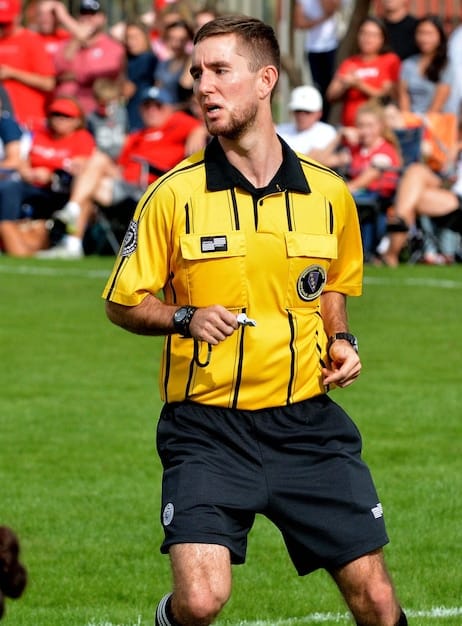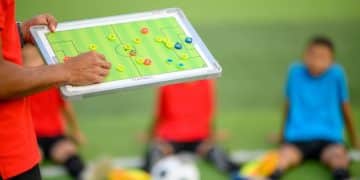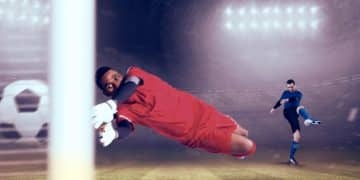La Liga’s Training Secrets: Unveiling Spanish Football Fitness

La Liga’s Training Regimen: What Makes Spanish Footballers So Fit? involves a multifaceted approach, blending intense tactical drilling, individualized strength and conditioning programs, meticulous nutritional strategies, and advanced recovery techniques, all tailored to the unique demands of Spanish football’s style of play.
What makes Spanish footballers so fit? The answer lies in La Liga’s Training Regimen: What Makes Spanish Footballers So Fit?, a comprehensive and scientific approach that prepares players for the demanding nature of the league. Let’s dive in discover how these athletes are molded into peak physical condition.
La Liga’s Meticulous Training Philosophies
La Liga clubs prioritize a holistic training philosophy, focusing not only on physical fitness but also on tactical intelligence and mental resilience. Each aspect is carefully integrated to ensure players are well-prepared for the intensity of the game.
These philosophies often blend traditional methods with cutting-edge sports science, creating a dynamic and effective training environment. The emphasis is on developing well-rounded athletes capable of performing at their peak.
Tactical Periodization
Tactical periodization is a key component. This approach organizes training sessions to reflect game-like situations, focusing on specific tactical objectives. This ensures that physical conditioning is always linked to the team’s strategic goals.
Integrated Training Approach
La Liga clubs also adopt an integrated training approach, combining strength, speed, and endurance work with technical drills and tactical exercises. This method fosters coordination between different aspects of the game, allowing players to seamlessly transition between physical and technical demands.

The end result is a highly refined and efficient training regimen that maximizes player performance.
- Emphasis on Game-Like Scenarios: Training replicates real match conditions.
- Holistic Development: Physical, tactical, and mental aspects are equally important.
- Data-Driven Adjustments: Training plans are continuously refined based on player performance and data analysis.
In conclusion, La Liga’s training philosophies are rooted in a deep understanding of football dynamics, ensuring players are not only physically fit but also tactically astute and mentally strong. This comprehensive approach is what sets the league apart.
Strength and Conditioning Regimens
The strength and conditioning regimens in La Liga are designed to build robust and resilient athletes. These programs are highly individualized, taking into account each player’s position, playing style, and specific physical needs.
La Liga clubs invest heavily in state-of-the-art equipment and employ highly qualified strength and conditioning coaches. This ensures that players receive the best possible guidance and support in their physical development.
Weight Training and Power Development
Weight training forms the foundation of many strength and conditioning programs. Players perform exercises that target key muscle groups, building overall strength and power. This is crucial for explosive movements such as sprinting, jumping, and tackling.
Agility and Speed Drills
Agility and speed drills are also incorporated to enhance quickness and reaction time. These drills challenge players to change direction rapidly and accelerate quickly, improving their overall athletic performance.
Advanced techniques, such as plyometrics and resistance training, are integrated as well.

- Individualized Programs: Tailored to each player’s specific role and needs.
- Cutting-Edge Equipment: Access to the latest in fitness technology.
- Expert Coaching: Guidance from top-tier strength and conditioning coaches.
In essence, La Liga’s strength and conditioning regimens are meticulously designed to optimize player performance and minimize the risk of injury. This rigorous approach is a key factor in the league’s success.
Nutritional Strategies for Peak Performance
Nutrition plays a pivotal role in La Liga’s training regimen. Clubs employ dedicated nutritionists who work closely with players to develop personalized meal plans. These plans are designed to fuel performance, promote recovery, and maintain optimal body composition.
The focus is on providing players with the right balance of macronutrients (carbohydrates, proteins, and fats) and micronutrients (vitamins and minerals) to support their intense training schedules.
Hydration Protocols
Hydration protocols are strictly enforced, with players encouraged to drink plenty of water throughout the day. Electrolyte drinks are also used to replenish fluids and minerals lost during training and matches.
Supplementation
Supplementation is carefully managed, with nutritionists advising players on the appropriate use of vitamins, minerals, and other supplements. The goal is to address any nutritional deficiencies and optimize overall health.
Dietary adjustments based on real-time body metrics is prevalent.
- Personalized Meal Plans: Tailored to individual needs and training demands.
- Macronutrient Balance: Optimized for energy, recovery, and performance.
- Hydration and Supplementation: Strictly managed for optimal health.
In summary, La Liga’s nutritional strategies are essential for achieving peak performance on the field. The emphasis on personalized meal plans, hydration, and supplementation ensures that players are properly fueled and ready to compete.
Recovery and Regeneration Methods
Recovery and regeneration are integral components of La Liga’s training regimen. Clubs invest heavily in resources and technologies to help players recover quickly and effectively from training and matches.
The focus is on minimizing muscle soreness, reducing fatigue, and promoting overall well-being. This involves a combination of active recovery, passive recovery, and advanced therapies.
Active Recovery Techniques
Active recovery techniques, such as light jogging and stretching, are used to promote blood flow and reduce muscle stiffness. These techniques help to flush out metabolic waste and accelerate the healing process.
Cold Water Immersion and Cryotherapy
Cold water immersion and cryotherapy are also commonly used to reduce inflammation and muscle soreness. Players immerse themselves in cold water or enter cryotherapy chambers for a short period of time, experiencing a rapid decrease in body temperature.
Sleep optimization and mental relaxation are also paramount.
- Active Recovery: Light exercise to promote blood flow and reduce stiffness.
- Cold Therapy: Techniques to reduce inflammation and muscle soreness.
- Sleep and Relaxation: Prioritizing rest and mental well-being.
In conclusion, La Liga’s recovery and regeneration methods are crucial for maintaining player health and performance throughout the season. By prioritizing recovery, clubs are able to keep their players fresh and ready to compete at their best.
The Role of Sports Science and Technology
Sports science and technology play a pivotal role in La Liga’s training regimen. Clubs utilize advanced tools and techniques to monitor player performance, track physiological metrics, and optimize training programs.
This data-driven approach allows coaches and trainers to make informed decisions about training intensity, recovery strategies, and injury prevention.
GPS Tracking and Wearable Sensors
GPS tracking and wearable sensors are used to monitor player movements, heart rate, and other physiological parameters during training and matches. This data provides valuable insights into player workload and fatigue levels.
Data Analytics and Performance Modeling
Data analytics and performance modeling are used to identify patterns and trends in player performance. This helps coaches to tailor training programs to individual needs and optimize overall team performance.
Virtual reality and other simulated game environments are also used for training.
- GPS Tracking: Monitoring player movements and physiological metrics.
- Data Analytics: Identifying patterns and trends in performance.
- Performance Modeling: Optimizing training programs and team strategies.
In essence, La Liga’s embrace of sports science and technology has revolutionized the way players are trained and managed. This data-driven approach ensures that players are performing at their peak potential while minimizing the risk of injury.
Mental Preparation and Psychological Resilience
Mental preparation and psychological resilience are increasingly recognized as crucial components of La Liga’s training regimen. Clubs employ sports psychologists to work with players on developing mental skills, improving focus, and managing stress.
The goal is to create mentally strong and resilient athletes who can perform under pressure and bounce back from setbacks.
Visualization and Mindfulness Techniques
Visualization and mindfulness techniques are used to help players prepare mentally for games and cope with the demands of competition. These techniques promote focus, reduce anxiety, and enhance overall mental well-being.
Team Building and Cohesion
Team building and cohesion exercises are also incorporated to foster a sense of unity and camaraderie within the squad. This helps to create a positive and supportive team environment.
One-on-one counseling is now a common practice.
- Mental Skills Training: Developing focus, managing stress, and improving confidence.
- Visualization and Mindfulness: Preparing mentally for games and competition.
- Team Building: Fostering unity, camaraderie, and support.
In summary, La Liga’s emphasis on mental preparation and psychological resilience is essential for creating well-rounded and successful athletes. By addressing the mental aspects of the game, clubs are able to unlock players’ full potential and achieve greater success on the field.
| Key Point | Brief Description |
|---|---|
| ⚽ Tactical Periodization | Training sessions mirror game situations, linking physical conditioning to strategic objectives. |
| 💪 Strength Regimens | Individualized programs enhance strength, power, and agility, reducing injury risks. |
| 🍎 Nutritional Plans | Personalized diets and hydration strategies optimize energy, recovery, and overall health. |
| 🧠 Mental Preparation | Mental skills training and team building foster focus, resilience, and unity within the squad. |
Frequently Asked Questions
▼
Tactical periodization is a training approach where sessions mimic game situations, seamlessly linking physical conditioning with strategic objectives. This ensures players are prepared for real match conditions.
▼
Nutritional strategies are tailored to individual needs, considering factors like position, playing style, and metabolic rate. Dedicated nutritionists design meal plans to optimize energy levels and overall health.
▼
Technology, such as GPS tracking and wearable sensors, monitors players’ movements and physiological metrics. This data helps coaches refine training and recovery strategies improving performance and reducing injury risks.
▼
Mental preparation enhances focus, reduces anxiety, and builds resilience. Techniques like visualization and team building foster mental fortitude, helping players perform optimally under pressure and manage stress effectively.
▼
La Liga clubs prioritize recovery by using active and passive methods. Active recovery includes light exercise, while passive methods include ice baths, sleep optimization, and relaxation techniques to maintain player’s peak condition.
Conclusion
In conclusion, the fitness of Spanish footballers in La Liga is a result of a comprehensive and multi-faceted training approach. By integrating tactical periodization, individualized strength and conditioning, meticulous nutritional strategies, advanced recovery techniques, sports science, and mental preparation, La Liga clubs ensure that their players are among the fittest and most resilient in the world. This comprehensive approach contributes significantly to the high level of competition and success seen in La Liga.





